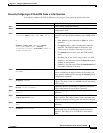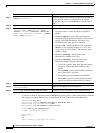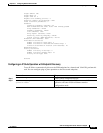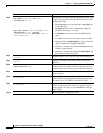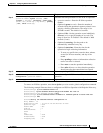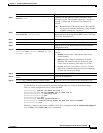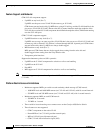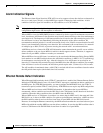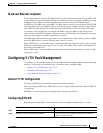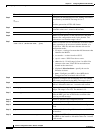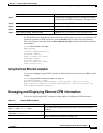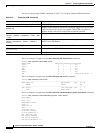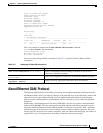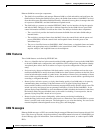
57-27
Software Configuration Guide—Release 15.0(2)SG
OL-23818-01
Chapter 57 Configuring Ethernet OAM and CFM
Understanding CFM ITU-T Y.1731 Fault Management
–
802.3ah interworking with CFM C-VLAN
–
CFM C-VLAN IP SLAs
–
CFM C-VLAN MIP autocreation
–
CFM C-VLAN with One-to-One VLAN mapping on Trunk ports.
Understanding CFM ITU-T Y.1731 Fault Management
The ITU-T Y.1731 feature provides new CFM functionality for fault and performance management for
service providers in large network. The switch supports Ethernet Alarm Indication Signal (ETH-AIS),
Ethernet Remote Defect Indication (ETH-RDI), Ethernet Locked Signal (ETH-LCK), and Ethernet
Multicast Loopback Message (MCAST-LBM) functionality for fault detection, verification, and
isolation.
• Y.1731 Terminology, page 57-27
• Alarm Indication Signals, page 57-28
• Ethernet Remote Defect Indication, page 57-28
• Multicast Ethernet Loopback, page 57-29
Y.1731 Terminology
• Server MEP—the combination of the server layer termination function and server or Ethernet
adaptation layer termination function or server or Ethernet adaptation function, where the server
layer termination function is expected to run OAM mechanisms specific to the server layer. The
supported mechanisms are link up, link down, and 802.3ah.
• Server layer—a virtual MEP layer capable of detecting fault conditions.
• Defect conditions:
–
Loss of continuity (LOC): the MEP stopped receiving CCM frames from a peer MEP
–
Mismerge: the MEP received a CCM frame with a correct maintenance level (matching the MEP
level) but an incorrect maintenance ID.
–
Unexpected MEP: the MEP received a CCM frame with the correct maintenance level
(matching the MEP’s level) and correct maintenance ID, but an unexpected MEP ID.
–
Unexpected maintenance level: the MEP received a CCM frame with an incorrect maintenance
level.
–
Unexpected period: the MEP received a CCM frame with a correct maintenance level, a correct
maintenance ID, a correct MEP ID, but a different transmission period field.
• Signal fail—the MEP declares a signal fail condition when it detects a defect condition.
• Alarm Indication Signal (AIS) condition—the MEP received an AIS frame.
• Remote Defect Indication (RDI) condition—The MEP received a CCM frame with the RDI field set.



